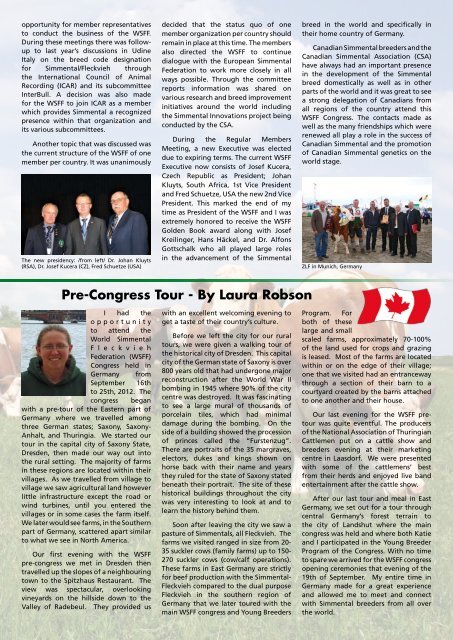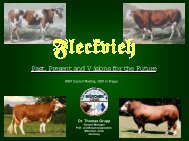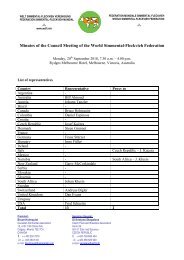By Bruce Holmquist - World Simmental Fleckvieh Federation
By Bruce Holmquist - World Simmental Fleckvieh Federation
By Bruce Holmquist - World Simmental Fleckvieh Federation
You also want an ePaper? Increase the reach of your titles
YUMPU automatically turns print PDFs into web optimized ePapers that Google loves.
opportunity for member representatives<br />
to conduct the business of the WSFF.<br />
During these meetings there was followup<br />
to last year’s discussions in Udine<br />
Italy on the breed code designation<br />
for <strong>Simmental</strong>/<strong>Fleckvieh</strong> through<br />
the International Council of Animal<br />
Recording (ICAR) and its subcommittee<br />
InterBull. A decision was also made<br />
for the WSFF to join ICAR as a member<br />
which provides <strong>Simmental</strong> a recognized<br />
presence within that organization and<br />
its various subcommittees.<br />
Another topic that was discussed was<br />
the current structure of the WSFF of one<br />
member per country. It was unanimously<br />
decided that the status quo of one<br />
member organization per country should<br />
remain in place at this time. The members<br />
also directed the WSFF to continue<br />
dialogue with the European <strong>Simmental</strong><br />
<strong>Federation</strong> to work more closely in all<br />
ways possible. Through the committee<br />
reports information was shared on<br />
various research and breed improvement<br />
initiatives around the world including<br />
the <strong>Simmental</strong> Innovations project being<br />
conducted by the CSA.<br />
During the Regular Members<br />
Meeting, a new Executive was elected<br />
due to expiring terms. The current WSFF<br />
Executive now consists of Josef Kucera,<br />
Czech Republic as President; Johan<br />
Kluyts, South Africa, 1st Vice President<br />
and Fred Schuetze, USA the new 2nd Vice<br />
President. This marked the end of my<br />
time as President of the WSFF and I was<br />
extremely honored to receive the WSFF<br />
Golden Book award along with Josef<br />
Kreilinger, Hans Häckel, and Dr. Alfons<br />
Gottschalk who all played large roles<br />
The new presidency: /from left/ Dr. Johan Kluyts in the advancement of the <strong>Simmental</strong><br />
(RSA), Dr. Josef Kucera (CZ), Fred Schuetze (USA) ZLF in Munich, Germany<br />
Pre-Congress Tour - <strong>By</strong> Laura Robson<br />
I had the<br />
o p p o r t u n i t y<br />
to attend the<br />
<strong>World</strong> <strong>Simmental</strong><br />
F l e c k v i e h<br />
<strong>Federation</strong> (WSFF)<br />
Congress held in<br />
Germany from<br />
September 16th<br />
to 25th, 2012. The<br />
congress began<br />
with a pre-tour of the Eastern part of<br />
Germany where we travelled among<br />
three German states; Saxony, Saxony-<br />
Anhalt, and Thuringia. We started our<br />
tour in the capital city of Saxony State,<br />
Dresden, then made our way out into<br />
the rural setting. The majority of farms<br />
in these regions are located within their<br />
villages. As we travelled from village to<br />
village we saw agricultural land however<br />
little infrastructure except the road or<br />
wind turbines, until you entered the<br />
villages or in some cases the farm itself.<br />
We later would see farms, in the Southern<br />
part of Germany, scattered apart similar<br />
to what we see in North America.<br />
Our first evening with the WSFF<br />
pre-congress we met in Dresden then<br />
travelled up the slopes of a neighbouring<br />
town to the Spitzhaus Restaurant. The<br />
view was spectacular, overlooking<br />
vineyards on the hillside down to the<br />
Valley of Radebeul. They provided us<br />
with an excellent welcoming evening to<br />
get a taste of their country’s culture.<br />
Before we left the city for our rural<br />
tours, we were given a walking tour of<br />
the historical city of Dresden. This capital<br />
city of the German state of Saxony is over<br />
800 years old that had undergone major<br />
reconstruction after the <strong>World</strong> War II<br />
bombing in 1945 where 90% of the city<br />
centre was destroyed. It was fascinating<br />
to see a large mural of thousands of<br />
porcelain tiles, which had minimal<br />
damage during the bombing. On the<br />
side of a building showed the procession<br />
of princes called the “Furstenzug”.<br />
There are portraits of the 35 margraves,<br />
electors, dukes and kings shown on<br />
horse back with their name and years<br />
they ruled for the state of Saxony stated<br />
beneath their portrait. The site of these<br />
historical buildings throughout the city<br />
was very interesting to look at and to<br />
learn the history behind them.<br />
Soon after leaving the city we saw a<br />
pasture of <strong>Simmental</strong>s, all <strong>Fleckvieh</strong>. The<br />
farms we visited ranged in size from 20-<br />
35 suckler cows (family farms) up to 150-<br />
270 suckler cows (cow/calf operations).<br />
These farms in East Germany are strictly<br />
for beef production with the <strong>Simmental</strong>-<br />
<strong>Fleckvieh</strong> compared to the dual purpose<br />
<strong>Fleckvieh</strong> in the southern region of<br />
Germany that we later toured with the<br />
main WSFF congress and Young Breeders<br />
breed in the world and specifically in<br />
their home country of Germany.<br />
Canadian <strong>Simmental</strong> breeders and the<br />
Canadian <strong>Simmental</strong> Association (CSA)<br />
have always had an important presence<br />
in the development of the <strong>Simmental</strong><br />
breed domestically as well as in other<br />
parts of the world and it was great to see<br />
a strong delegation of Canadians from<br />
all regions of the country attend this<br />
WSFF Congress. The contacts made as<br />
well as the many friendships which were<br />
renewed all play a role in the success of<br />
Canadian <strong>Simmental</strong> and the promotion<br />
of Canadian <strong>Simmental</strong> genetics on the<br />
world stage.<br />
Program. For<br />
both of these<br />
large and small<br />
scaled farms, approximately 70-100%<br />
of the land used for crops and grazing<br />
is leased. Most of the farms are located<br />
within or on the edge of their village;<br />
one that we visited had an entranceway<br />
through a section of their barn to a<br />
courtyard created by the barns attached<br />
to one another and their house.<br />
Our last evening for the WSFF pretour<br />
was quite eventful. The producers<br />
of the National Association of Thuringian<br />
Cattlemen put on a cattle show and<br />
breeders evening at their marketing<br />
centre in Laasdorf. We were presented<br />
with some of the cattlemens’ best<br />
from their herds and enjoyed live band<br />
entertainment after the cattle show.<br />
After our last tour and meal in East<br />
Germany, we set out for a tour through<br />
central Germany’s forest terrain to<br />
the city of Landshut where the main<br />
congress was held and where both Katie<br />
and I participated in the Young Breeder<br />
Program of the Congress. With no time<br />
to spare we arrived for the WSFF congress<br />
opening ceremonies that evening of the<br />
19th of September. My entire time in<br />
Germany made for a great experience<br />
and allowed me to meet and connect<br />
with <strong>Simmental</strong> breeders from all over<br />
the world.




